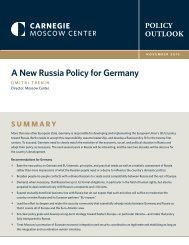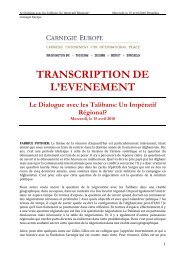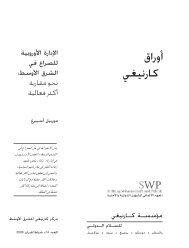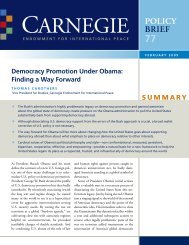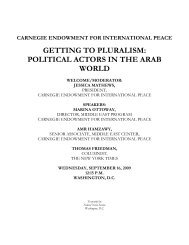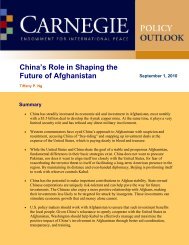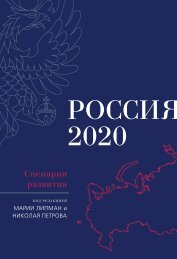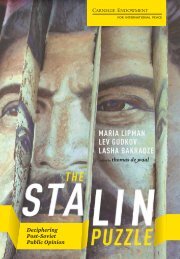An Introduction - Carnegie Endowment for International Peace
An Introduction - Carnegie Endowment for International Peace
An Introduction - Carnegie Endowment for International Peace
Create successful ePaper yourself
Turn your PDF publications into a flip-book with our unique Google optimized e-Paper software.
12 | democracy challenged<br />
subtitle: Tentative Conclusions about Uncertain Democracies. As is<br />
often the case with successful works, these highly qualified conclusions<br />
took on a life of their own, losing their nuances and turning into<br />
outright policy prescriptions. In the midst ofthe transition from<br />
apartheid in South Africa in the early 1990s, I heard many political<br />
commentators invoke O’Donnell and Schmitter in support oftheir favorite<br />
policies, ignoring the two authors’ careful qualifications of their<br />
conclusions. A similar fate has befallen Robert Putnam, whose concept<br />
ofsocial capital has been trans<strong>for</strong>med to denote not a culture of<br />
trust and cooperation developed over centuries, but something that<br />
could be quickly created by funding NGOs and training them in the<br />
techniques oflobbying the government, administering funds, and reporting<br />
to donors. 12<br />
The Donors’ Model<br />
The model ofdemocratization that donors have developed through<br />
this process ofdistilling the complex lessons ofhistory into policy prescriptions<br />
capable ofimplementation is simple. Democratization is interpreted<br />
as a three-phase process: liberalization, lasting at most a few<br />
years, but preferably much less; the transition proper, accomplished<br />
through the holding ofa multiparty election; and consolidation, a protracted<br />
process ofstrengthening institutions and deepening a democratic<br />
culture. The tools used to facilitate this project are also fairly<br />
simple: in the liberalization phase, support <strong>for</strong> civil society and the independent<br />
press; during the transition, support <strong>for</strong> elections, including<br />
voter education, training ofNGOs <strong>for</strong> election observing, and,<br />
more rarely, training <strong>for</strong> all political parties in the techniques of organizing<br />
and campaigning; and in the consolidation phase, new programs<br />
to build democratic institutions and the rule oflaw, as well as<br />
the continuation ofactivities to further strengthen civil society and<br />
the media, educate citizens, or train parties. 13<br />
The model is considered applicable to any country, although different<br />
conditions require some adjustment in the programs implemented.<br />
This is because the real obstacles to democracy are authoritarian<br />
leaders’ resistance to change, which can be softened with




